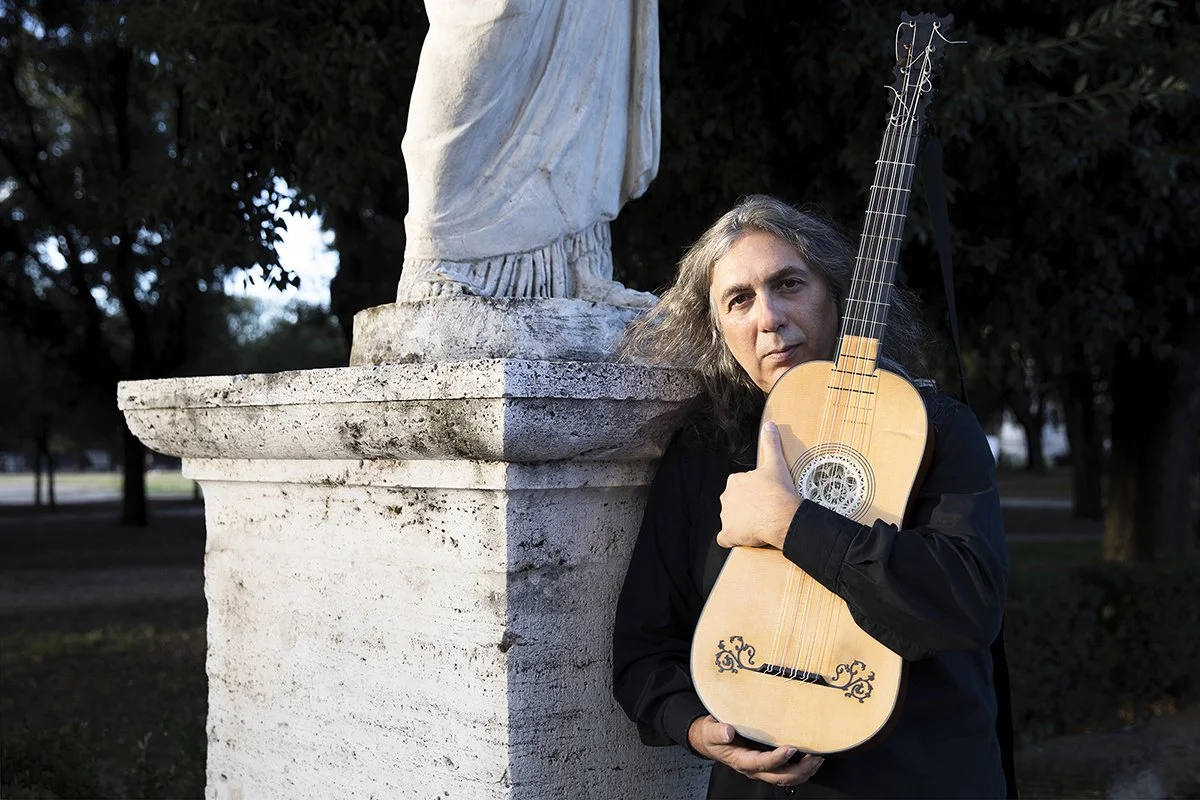Stringed-instrument virtuoso Stefano Maiorana crosses centuries in Secret Pages for Theorbo
Both traditional and groundbreaking, works from the 17th century and the present day mingle in this exploration of the musical riches of Venice
Stefano Maiorana. Photo by Francesca Pompei
Vancouver New Music and Early Music Vancouver present Stefano Maiorana: Secret Pages for Theorbo at Pacific Spirit United Church on April 26
DESPITE AN OVERLOAD of tourists, a plague of pigeons, and the looming threat of rising sea levels, Venice remains one of the finest places in Europe to experience the glories of the past while enjoying the comforts of the present. And it’s not necessary to dip one’s toes into the Laguna Veneta to experience this: Secret Pages for Theorbo, a collaboration between Early Music Vancouver and New Music Vancouver, will take you there.
The concert, at Pacific Spirit United Church on April 26, is more than just a joint project between two of our city’s most thoughtful production companies: it has also been developed by the early music scholar and stringed-instrument virtuoso Stefano Maiorana and the composer Claudio Ambrosini, with input from Venice itself. Also contributing will be Giovanni Girolamo Kapsberger, who died in 1651 but who will be vividly present as his music “converses” with Ambrosini’s. The format, basically, is a kind of call-and-response between a pioneering composer for the theorbo—a long, 14-stringed member of the lute family—and his living Italian counterpart, mediated by Maiorana’s skilled fingers and fertile imagination.
The first two works on the program—an untitled sketch from one of Kapsberger’s teaching manuals, followed by Ambrosini’s pensive, enigmatic “Tastata”—give a clear indication of how things will go.
“When I chose Kapsberger’s pieces to include in the program, I decided to select only pieces from manuscripts,” Maiorana explains in an email interview facilitated by Vancouver New Music artistic director Giorgio Magnanensi. “I really liked the idea of pairing the manuscripts that Ambrosini sent me with Kapsberger's manuscripts. Between the first piece in the program and ‘Tastata’, there’s like a hand extended and received across centuries. Kapsberger’s score is part of a small study book that he used with his students, and this fragment ends suddenly without a conclusion, probably leaving it to his student to continue the piece according to the master’s style. So then ‘Tastata’, after an initial ornament, begins precisely on the note left suspended by Kapsberger. It seemed to me a beautiful way to begin a program of this type.”
Venice enters the music in several ways. Ambrosini has incorporated environmental recordings—waves rippling against a Venetian breakwater, children playing next to Claudio Monteverdi’s tomb—into some of his works, and it’s significant that both he and Kapsberger are natives of the island city.
“Ambrosini is Venetian and deeply connected to the musical tradition of his city,” Maiorana confirms. “Kapsberger was also born in Venice and subsequently lived in Rome, where he held a position of absolute prominence in the musical landscape of the early 17th century. I was born and live in Rome. It’s quite curious how Venice and Rome intertwine in these three people. While for Ambrosini Venice is a fundamental reference point, it’s difficult to say exactly what Kapsberger took with him from Venice. Some musicological studies emphasize how his toccatas, a genre in which he was particularly revolutionary, may have a connection with the Venetian tradition. I think this is true, and something else that certainly unites Ambrosini and Kapsberger is their musical research into the idiomatic possibilities of the theorbo. Both are trying to understand what new things the instrument can offer, and the environmental recordings will present an opportunity to hear the sound of a city that is certainly unique in the world. It’s a city to see and hear at least once.”
Maiorana had the additional bonus of experiencing Venice in a way that, with any luck, won’t be repeated: he and Ambrosini developed Secret Pages for Theorbo during the Covid pandemic. Walking through the deserted city allowed both performer and composer to experience Venice as it was before air travel, speedboats, and overheard cellphone chatter. Time, Maiorana says, was “suspended”, allowing the Renaissance and Baroque eras to more fully enter the now. This might also have strengthened the bond between composer and interpreter—although, as Maiorana notes, “when two people with very different skills have the fortune to meet and embark on a journey together, something interesting always emerges.
“I can speak about my contribution,” he continues. “As a performer specializing in plucked instruments of early music, I think I mainly shared, during the years we worked closely together, a deep knowledge of this music and of the theorbo in particular, along with my personal style of playing Kapsberger, a composer to whom I had already dedicated an album and whom I’ve always found very interesting. There was a continuous exchange with Ambrosini regarding the realization of his pieces. This allowed me to better understand an author’s intentions while at the same time, I hope, stimulating him to explore more deeply the possibilities of such a fascinating instrument. In a certain sense, perhaps what united us most while working on Secret Pages was our taste for a challenge.”
And for surprise too. Baroque specialists might be shocked by how readily Ambrosini’s occasionally abstract adventures pair with Kapsberger’s more familiar harmonies, while devotees of the avant-garde arts will be reminded of how a thoughtful and inventive interpreter can find contemporary meaning in an antique score. As Magnanensi points out, “This dialogue demonstrates how music, whether Baroque or experimental, creates powerful spaces for imagination. Ambrosini’s pieces offer fresh perspectives on early music, while Stefano Maiorana's interpretations and improvisations reveal the expressive potential hidden within some of Kapsberger’s fragments and drafts. The soundscape recordings of Venice further ground this experience in a specific emotional and geographic context, inviting reflection on place, memory, and imagination.
“Ultimately,” he adds, “these sonic dialogues connect two musical worlds and their audiences, nurturing empathy, curiosity, and a deeper appreciation for musicality that transcends time and space.” ![]()

























